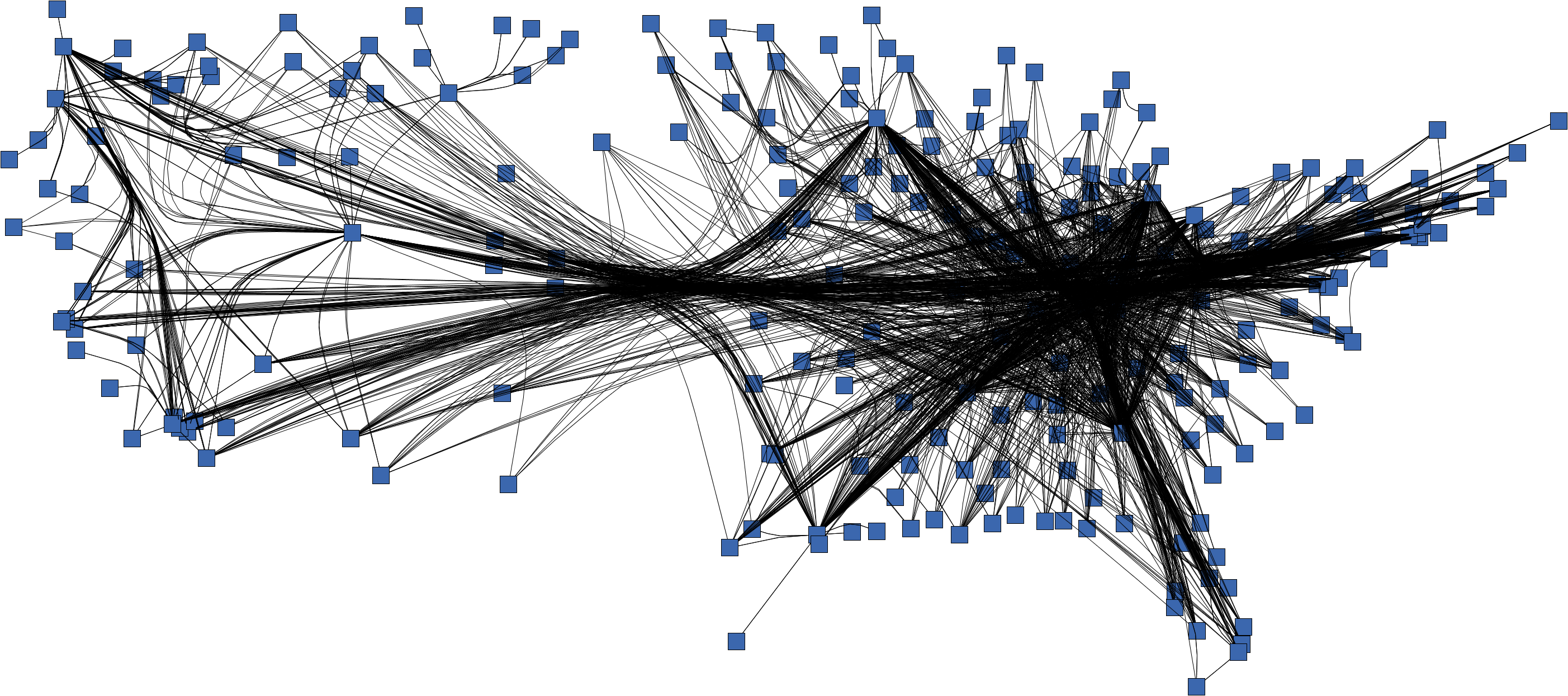 y.layout.AbstractLayoutStage
y.layout.AbstractLayoutStage
 y.layout.router.EdgeBundlingStage
y.layout.router.EdgeBundlingStage
|
Search this API | ||||||||
| PREV CLASS NEXT CLASS | FRAMES NO FRAMES | ||||||||
| SUMMARY: NESTED | FIELD | CONSTR | METHOD | DETAIL: FIELD | CONSTR | METHOD | ||||||||
java.lang.Objecty.layout.AbstractLayoutStage
y.layout.router.EdgeBundlingStage
public class EdgeBundlingStage
A LayoutStage that bundles the edges of general undirected graphs to avoid visual cluttering.
Bundling together multiple edges means that their common parts are to some degree merged into a bundled
part, which is a useful technique to increase the readability of straight-line graph drawings with a high number of
edges that connect a comparably small number of nodes.
This stage provides means to generate bundled edge paths for any given layout, i.e., the layout
generated by a specified core layout algorithm.
To determine whether two edges can be bundled, the algorithm computes a compatibility measure that is composed
of various criteria (e.g. edges that are closer together or have similar length are more compatible).
Note that this stage ignores the edge bends and handles them all as straight-lines.
Furthermore, it doesn't prevent overlaps between nodes and edges.

A result of this stage with default settings
The implemented algorithm is based on the description in: "Force-directed Edge Bundling for Graph Visualization" by Danny Holten and Jarke J. van Wijk, in Computer Graphics Forum 28(3): 893-990, 2009.
The main idea of the algorithm is that the edges are subdivided into segments and between each pair of consecutive subdivision points spring and electrostatic forces are exerted. At each iteration step, each subdivision point is moved according to the combined force exerted on it. The algorithm runs in six cycles and starts with an initial number of subdivision points for each edge and an initial step size that determines the distance to which each subdivision point can be moved in the direction of the combined force (exerted on it) at each iteration step of the algorithm. After each cycle run, the value of the step size is halved.
Global settings of the bundling can be configured using an EdgeBundling instance. In particular, it is possible
to determine which of the edges are compatible and thus, can be bundled together by specifying the strength of the edge
bundles using the EdgeBundling.getBundlingStrength() property. For the particular algorithm,
the default value for this property is 0.4. The bundling quality
is related to the distance to which a subdivision point can be moved at each iteration step of the algorithm.
The default value is 1.
The individual style of each edge can be configured using an EdgeBundleDescriptor. A DataProvider
can be registered with the input graph with key EdgeBundling.EDGE_BUNDLE_DESCRIPTOR_DPKEY to assign
descriptors to edges. This allows, for example, to define which edges should actually be bundled.
To visualize better the result of the edge bundling algorithm, it is recommended that the edges are rendered using an opacity factor. In this manner, edges that are strongly bundled together will be emphasized more, in comparison to others that are not bundled.
bundling strength can significantly
affect the performance of the algorithm, especially for large graphs. A value close to 0.4 is recommended.
On the other hand, using zero values for the bundling strength or the
bundling quality leads to straight-line edges.O(N * graph.E()^2 * K) where: N is the number of iterations and
K the number of subdivision points per edge
| Field Summary |
|---|
| Fields inherited from interface y.layout.Layouter |
|---|
EDGE_ID_DPKEY, NODE_ID_DPKEY, NODE_TYPE_DPKEY, SELECTED_EDGES, SELECTED_NODES |
| Constructor Summary | |
|---|---|
EdgeBundlingStage()
Creates a new EdgeBundlingStage instance with default settings. |
|
EdgeBundlingStage(Layouter core)
Creates a new EdgeBundlingStage instance with the given core layout algorithm and default settings. |
|
| Method Summary | |
|---|---|
boolean |
canLayout(LayoutGraph graph)
Accepts all graphs that are accepted by the core layout algorithm. |
void |
doLayout(LayoutGraph graph)
Applies the edge bundling algorithm after invoking the core layout algorithm. |
EdgeBundling |
getEdgeBundling()
Returns the EdgeBundling instance that defines the settings of the edge bundling feature. |
long |
getMaximumDuration()
Returns the maximum duration in milliseconds that this bundling algorithm is allowed to run. |
void |
setMaximumDuration(long maximumDurationMillis)
Specifies the maximum duration in milliseconds that this bundling algorithm is allowed to run. |
| Methods inherited from class y.layout.AbstractLayoutStage |
|---|
canLayoutCore, doLayoutCore, getCoreLayouter, setCoreLayouter |
| Methods inherited from class java.lang.Object |
|---|
clone, equals, finalize, getClass, hashCode, notify, notifyAll, toString, wait, wait, wait |
| Constructor Detail |
|---|
public EdgeBundlingStage()
EdgeBundlingStage instance with default settings.
public EdgeBundlingStage(Layouter core)
EdgeBundlingStage instance with the given core layout algorithm and default settings.
core - the core layout algorithm| Method Detail |
|---|
public void setMaximumDuration(long maximumDurationMillis)
The duration needs to be non-negative.
Long.MAX_VALUE. The bundling algorithm runs unrestricted.maximumDurationMillis - the non-negative duration in milliseconds
java.lang.IllegalArgumentException - if the specified duration has a negative valuepublic long getMaximumDuration()
The duration needs to be non-negative.
setMaximumDuration(long)public EdgeBundling getEdgeBundling()
EdgeBundling instance that defines the settings of the edge bundling feature.
The specified EdgeBundling defines global bundling properties. Settings for individual
edges can be defined by assigning an EdgeBundleDescriptor to an edge using a DataProvider
registered with key EdgeBundling.EDGE_BUNDLE_DESCRIPTOR_DPKEY.
By default, all edges are bundled (property EdgeBundleDescriptor.isBundled() of
the default bundle descriptor is enabled).
The default for EdgeBundling.getBundlingStrength() is 0.4 and the default for
property EdgeBundling.getBundlingQuality() is 1.0.
EdgeBundling instance defining the edge bundling setuppublic boolean canLayout(LayoutGraph graph)
core layout algorithm. If the core layout
algorithm is null, every graph gets accepted.
graph - the graph.
true if the core layout algorithm accepts the graph, false otherwise.Layouter.doLayout(LayoutGraph)public void doLayout(LayoutGraph graph)
core layout algorithm.
graph - the input graphLayouter.canLayout(LayoutGraph)
|
© Copyright 2000-2025, yWorks GmbH. All rights reserved. |
||||||||
| PREV CLASS NEXT CLASS | FRAMES NO FRAMES | ||||||||
| SUMMARY: NESTED | FIELD | CONSTR | METHOD | DETAIL: FIELD | CONSTR | METHOD | ||||||||